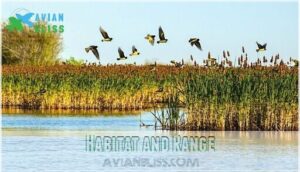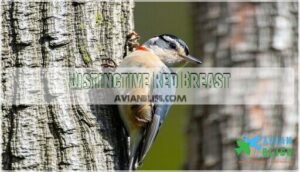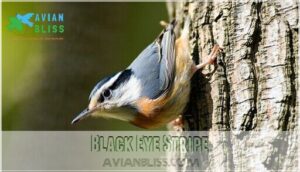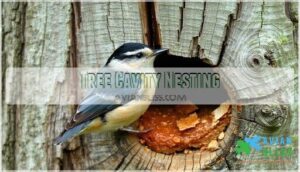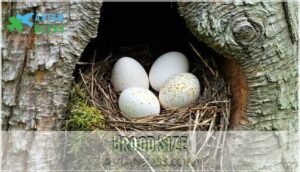This site is supported by our readers. We may earn a commission, at no cost to you, if you purchase through links.
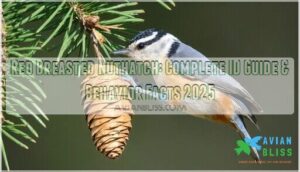
These acrobatic birds navigate conifer trees headfirst, their blue-gray backs blending with bark as they search for insects and seeds.
Unlike their white-breasted cousins, they prefer spruce and fir forests, often migrating south when cone crops fail.
Their nasal "yank-yank" calls echo through the canopy while they stuff tree crevices with pitch for protection.
These tiny gymnasts weigh barely half an ounce yet perform aerial stunts that would make circus performers jealous, revealing fascinating survival strategies with their unique foraging techniques.
Table Of Contents
- Key Takeaways
- Red Breasted Nuthatch
- Habitat and Range
- Appearance and Identification
- Feeding and Foraging
- Nesting and Breeding
- Behavior and Vocalizations
- Frequently Asked Questions (FAQs)
- Where can I find a red-breasted nuthatch?
- What does a red-breasted nuthatch look like?
- Are red-breasted nuthatches aggressive?
- Are red-breasted nuthatch endangered?
- How old is a red-breasted nuthatch?
- Do red-breasted nuthatch have a call?
- Are red-breasted nuthatches rare?
- Where do red-breasted nuthatches live?
- What does it mean when you see a nuthatch?
- Are Red-breasted Nuthatches rare?
- Conclusion
Key Takeaways
- You’ll identify red-breasted nuthatches by their distinctive rust-colored underparts, bold black eye stripe, and blue-gray back that makes them unmistakable among small forest birds.
- You can spot these acrobatic climbers moving headfirst down tree trunks in coniferous forests, where they prefer spruce, fir, and pine trees over deciduous woods.
- You’ll hear their nasal "yank-yank" calls echoing through the canopy as they forage for insects in summer and shift to seeds during winter months.
- You’ll notice their irregular migration patterns during poor cone crop years, when these northern birds move south in dramatic irruptions that can bring them to your backyard feeders.
Red Breasted Nuthatch
You’ll recognize the Red-breasted Nuthatch by its compact, sparrow-sized body and distinctive rusty-orange underparts that contrast sharply with its blue-gray back.
This tiny acrobat measures just 4.3 inches long and weighs less than half an ounce, making it noticeably smaller than its White-breasted cousin.
Physical Characteristics
You’ll notice the Redbreasted Nuthatch’s compact, barrel-chested build immediately.
This sparrow-sized bird measures just 4.3 inches long with a 7.9-inch wingspan, weighing under half an ounce.
Its distinctive plumage details include blue-gray upperparts and rusty-orange underparts.
The sharp, chisel-like bill shape helps distinguish it from other species.
Strong leg strength and curved claws enable its signature headfirst tree climbing.
Short wing morphology and minimal tail length complete its streamlined profile.
Identification Features
You can identify a Redbreasted Nuthatch by examining several key features that distinguish it from other woodland birds.
The bird identification process becomes straightforward when you focus on these distinctive characteristics that create its unique color pattern.
Key identification markers include:
- Bill Shape: Long, pointed, and chisel-like for probing bark crevices
- Plumage Details: Blue-gray back contrasting with rusty-orange underparts
- Tail Length: Remarkably short and square-tipped
- Iris Color: Dark eyes with prominent black eye stripe
The bird coloration shows white cheeks and throat, while size and shape remain compact with virtually no visible neck.
Leg Color appears dark, complementing the overall appearance.
Observing the beak shape reveals feeding habits.
Size and Weight
Red-breasted Nuthatches showcase remarkable consistency in their compact build regardless of gender.
You’ll find these sparrow-sized birds measuring 4.3 inches in average length with minimal sexual dimorphism between males and females.
Their weight variation spans 0.3-0.5 ounces, while wingspan measurements reach 7.1-7.9 inches.
Body proportions emphasize their barrel-chested appearance – virtually no neck connects their rounded head to their plump torso.
This size and shape combination creates exceptional climbing abilities through their perfectly balanced, lightweight frame, allowing for remarkable consistency and a compact build.
Habitat and Range
You’ll find Red-breasted Nuthatches primarily in evergreen forests of spruce, fir, pine, and hemlock, though eastern populations also use deciduous woods like aspen and oak.
These birds migrate irregularly, with some populations moving south during harsh winters when cone crops fail in their northern breeding grounds.
Coniferous Forests
Deep within evergreen forests, you’ll find the red breasted nuthatch’s true home among towering conifers.
Nestled high in towering conifers, these acrobatic birds make evergreen forests their perfect woodland sanctuary.
These birds show strong tree dependence on spruce, fir, pine, and hemlock for nesting and foraging. Forest composition varies regionally – western populations favor ponderosa pine forests while eastern birds adapt to mixed deciduous-coniferous stands.
Climate impact drives seasonal movements when cone crops fail. Bird habitat quality depends on mature trees with decaying wood for cavity excavation.
Consider providing pine homes for birds to support local populations.
Migration Patterns
You’ll witness fascinating bird migration patterns when these nuthatches set out on irregular journeys called irruptive movements.
Unlike predictable seasonal migrations, their winter range expands dramatically southward during cone crop failures every 2-4 years.
Climate change affects these bird migration patterns, with southern expansion reaching Texas and Florida during major irruptions.
These movements highlight the importance of protecting stopover sites for refueling.
Bird rangemaps show dramatic fluctuations as populations follow food availability rather than fixed schedules across their bird region.
Wintering Grounds
During poor cone crop years, these birds abandon their northern strongholds for Southern Expansion across the continent.
When winter food runs scarce, these tiny wanderers launch epic journeys thousands of miles from home.
You’ll spot them from Alaska’s coniferous trees down to the Gulf Coast when Food Availability drives massive irruptions.
Climate Impact and Habitat Selection determine their winter range, with birds choosing pine forests over Urban Habitats.
Bird migration patterns shift dramatically based on bird range conditions affecting bird foraging success at bird feeders.
Red-breasted nuthatches often irrupt southward during these times.
- Watch for sudden influxes at your backyard feeders during "invasion years" – nature’s own surprise party
- These hardy travelers may appear thousands of miles from home, desperately seeking survival
- Your local park’s conifers become emergency shelters for exhausted, displaced wanderers
Appearance and Identification
You’ll instantly recognize the Red-breasted Nuthatch by its striking rust-colored underparts and bold black eye stripe that cuts across its white cheek.
This compact bird displays blue-gray upperparts and moves headfirst down tree trunks with remarkable agility.
Distinctive Red Breast
The male nuthatch’s rust-colored underside creates striking contrast against his blue-gray back, making him unmistakable among North American birds.
This vibrant bird color serves multiple purposes in the wild. Sexual selection drives the intensity factors of this distinctive marking, with brighter males often attracting more mates.
Geographic differences show some regional color variation across populations. The redbellied nuthatch’s camouflage purpose helps him blend with tree bark shadows while foraging, though his bright chest remains visible for bird identification by keen observers.
You can find nuthatch-themed merchandise online.
Black Eye Stripe
The nuthatch’s signature black eye stripe acts like a built-in mask, creating one of nature’s most reliable identification marks.
This bold facial feature helps you distinguish Red-breasted Nuthatches from other small birds in North American forests.
Key stripe characteristics include:
- Male identification: Males display darker, more pronounced stripes than females
- Juvenile stripes: Young birds show fainter, less defined markings
- Stripe variations: Width and intensity can vary slightly between individuals
- Camouflage function: The stripe breaks up the bird’s facial outline against tree bark
This distinctive marking remains consistent across all ages, making bird identification straightforward even for beginners watching nuthatch behavior. Overall, color combinations aid in quick ID.
Grayish-blue Back
Looking at a Red-breasted Nuthatch, you’ll notice the stunning blue-gray back coloration that provides excellent camouflage benefits against tree bark.
This distinctive plumage variation helps with bird identification among small birds. The back’s silvery-blue hue remains consistent across seasons, though juvenile backs appear slightly duller.
During back molting periods, new feathers emerge with the same blue-gray intensity. These bird physical traits make the nuthatch bird easily recognizable, as the contrasting bird characteristics between the colorful underparts and muted upperparts create perfect woodland camouflage for survival.
Many appreciate a nuthatch bird print as decor.
Feeding and Foraging
You’ll watch red-breasted nuthatches perform acrobatic feats as they forage, moving headfirst down tree trunks and hanging upside-down from branches with their strong claws.
These agile climbers shift their diet seasonally, hunting insects and spiders during summer months while relying heavily on conifer seeds throughout winter, utilizing their ability to forage.
Agile Climbers
You’ll witness remarkable Arboreal Adaptations when watching this nuthatch bird navigate tree trunks.
Their Strong Feet and curved claws enable impressive Climbing Techniques that other birds can’t match.
Watch them perform Headfirst Descent down bark surfaces or demonstrate Upside-Down Movement along branches.
Sitta canadensis uses specialized bird behavior to access insects hidden in bark crevices throughout coniferous forests, making their bird climbing abilities truly exceptional.
Insectivorous Diet
During summer months, you’ll find these acrobatic birds hunting spiders, beetles, caterpillars, and other insect prey with remarkable precision.
Their foraging techniques include bark-probing and branch-gleaning to locate larval consumption opportunities.
Seasonal variation affects their arthropod availability, making spring through fall prime hunting seasons.
Unfortunately, insecticide impact threatens their food sources, highlighting why maintaining chemical-free environments supports these dedicated insectivore birds and their specialized bird feeding behavior.
Seed Consumption
When winter arrives, you’ll notice these acrobatic birds shifting their bird diet dramatically toward seeds.
Their Seed Preferences become highly selective during cold months:
- Sunflower seeds and peanuts top their feeder visit choices
- Pine, spruce, and fir seeds dominate their Winter Diet naturally
- Caching Behavior involves wedging seeds into bark crevices for storage
- Seed Types like safflower and corn supplement their nutritional needs
This strategic bird feeding approach guarantees survival through harsh conditions.
They choose seeds based on seed selection behavior.
Nesting and Breeding
You’ll find red-breasted nuthatches excavating their own nest cavities in dead or decaying wood, typically 5-40 feet above ground in coniferous trees.
The female incubates 4-7 white eggs with reddish-brown spots for about 12 days while the male brings her food, which is a crucial aspect of their nesting behavior.
Tree Cavity Nesting
Red-breasted nuthatches are master home builders, using cavity excavation to create secure nesting sites in decaying wood.
You’ll find their nest cavities 5-40 feet high in dead or dying trees.
These clever birds apply pitch defense around entrance holes, smearing sticky tree sap to deter predators and competitors.
The female carefully selects nest materials like fur, feathers, and soft bark strips to line the excavated chamber.
Wood decay makes excavation easier, allowing pairs to hollow out cozy spaces in rotting trunks within days, using the natural process to their advantage with cavity excavation.
Parental Care
Both parents work as a dedicated team during nesting season. The female handles the Incubation Period of about 12 days while the male provides food.
After hatching, Nestling Development requires constant attention from both parents. Parental Roles shift as the male increases feeding duties.
- Female incubates bird eggs alone for approximately 12 days
- Male delivers food to incubating female throughout bird breeding season
- Both parents feed bird young continuously during nestling phase
- Fledgling Care extends beyond nest departure with ongoing bird parental care
Post-Fledging Support continues for weeks after young leave the nest.
Brood Size
You’ll typically find clutch size ranging from 5-8 eggs, with 6 being average.
Egg count can drop to just 2 or reach 8 in exceptional cases. Clutch variation depends on food abundance – years with plentiful insects support larger broods.
Hatching success occurs after 12-13 days of incubation.
Chick survival through the 18-21 day nestling period relies heavily on parental feeding. Brood development produces 4-8 fledglings annually, as these bird nesting specialists raise only one brood per year.
Behavior and Vocalizations
You’ll hear red-breasted nuthatches before you see them, as their distinctive nasal "yank-yank" calls echo through coniferous forests year-round.
These vocal little birds also produce surprisingly musical songs during breeding season, with males performing soft warbling melodies while displaying their courtship rituals.
Nasal Calls
Throughout winter months, you’ll recognize the Red-breasted Nuthatch by its distinctive nasal call that sounds like a tiny tin horn.
These bird vocalizations serve multiple purposes, from maintaining contact with mates to establishing territory.
Call frequency increases during breeding season, while alarm calls become sharper when predators approach.
Regional dialects exist across their range, with subtle variations in pitch and rhythm.
Bird sounds help you locate these small climbers even in dense coniferous forests.
Their nasal call functions as both identification marker and communication tool for birdwatchers.
Musical Songs
Beyond their nasal calls, you’ll hear males produce soft, musical songs during courtship displays.
These melodic sequences show remarkable Song Complexity compared to their harsh everyday vocalizations.
While regional dialects exist across their range, Song Learning appears limited in nuthatches.
Males rarely engage in Duet Singing, instead relying on solo performances to attract mates.
Their bird songs serve different Call Functions than their typical nasal call – the musical notes focus purely on reproduction rather than territory or alarm communication.
Social Interactions
Beyond their melodic vocalizations, red-breasted nuthatches display fascinating social behaviors that change with seasons.
You’ll observe distinct pair bonding through courtship feeding and coordinated calls between mates.
Their flock dynamics shift dramatically in winter, with up to 76% joining mixed-species groups for protection and resource sharing.
Territorial defense intensifies during breeding season, featuring aggressive displays and chase behaviors.
These birds excel at communication signals, using varied alarm calls to alert both their species and others to danger.
Their complex interactions also involve dominance at feeders, influencing access to resources.
- Pair bonding strengthens through mutual food caching and courtship feeding behaviors
- Flock dynamics provide 40% better predation protection in mixed-species winter groups
- Territorial defense covers up to 10,000 square meters during breeding season
- Communication signals include eavesdropping on other species’ warning calls for enhanced safety
Frequently Asked Questions (FAQs)
Where can I find a red-breasted nuthatch?
You’ll find these compact birds in evergreen forests of spruce, fir, and pine across northern and western North America.
They’re frequent backyard feeder visitors, especially during winter when they migrate south.
What does a red-breasted nuthatch look like?
Weighing just 3-5 ounces, you’ll spot this sparrow-sized bird by its distinctive black eye stripe, white eyebrow, blue-gray back, and rusty-red belly that makes it unmistakable among nuthatches.
Are red-breasted nuthatches aggressive?
You won’t find red-breasted nuthatches being particularly aggressive toward humans – they’re actually quite fearless and approachable. They’re more focused on their acrobatic tree-climbing adventures than picking fights.
Are red-breasted nuthatch endangered?
No, you shouldn’t worry about these birds disappearing. Red-breasted nuthatches aren’t endangered, though their numbers fluctuate with food supplies. They’re common across northern forests and adapting well to habitat changes.
How old is a red-breasted nuthatch?
Red-breasted nuthatches typically live 6-7 years in the wild, though some banded birds have reached 9 years.
You’ll find these hardy little climbers face challenges from predators, weather, and food scarcity that affect their lifespan.
Do red-breasted nuthatch have a call?
You’ll hear red-breasted nuthatches making nasal, yelping calls throughout the day. They’re quite vocal birds with rapid, high-pitched songs used during courtship displays and communication while foraging in coniferous forests.
Are red-breasted nuthatches rare?
Red-breasted nuthatches aren’t rare birds—they’re actually quite common in coniferous forests.
You’ll find them year-round in northern regions, though they migrate irregularly southward during harsh winters when food becomes scarce.
Where do red-breasted nuthatches live?
You’ll find these small birds throughout northern and western North America’s coniferous forests. They prefer spruce, fir, and pine trees, nesting from Alaska to the Great Lakes and Appalachian mountains.
What does it mean when you see a nuthatch?
Spotting nuthatches signals nature’s nearby presence – these acrobatic birds indicate healthy forests with abundant food sources, suggesting you’re in an environment where wildlife thrives and ecosystems remain balanced.
Are Red-breasted Nuthatches rare?
No, they’re not rare overall but show irregular distribution patterns.
You’ll find them commonly in northern coniferous forests, though populations fluctuate based on food availability, causing periodic southward movements during poor cone crop years.
Conclusion
Remarkably resilient red breasted nuthatches demonstrate nature’s perfect design through their specialized adaptations.
You’ve discovered how these compact acrobats master vertical navigation with their unique toe structure and climbing abilities.
Their distinctive markings, nasal calls, and pitch-smearing behaviors make identification straightforward once you know what to look for.
Whether they’re migrating through your area or establishing territory in nearby conifers, red breasted nuthatches reward patient observers with entertaining displays of agility and resourcefulness that showcase their remarkable survival skills.
- https://animaldiversity.org/accounts/Sitta_canadensis/
- https://glaszart.com/the-red-breasted-nuthatch-and-its-quirky-behavior/
- https://www.audubon.org/field-guide/bird/red-breasted-nuthatch
- https://txtbba.tamu.edu/species-accounts/red-breasted-nuthatch/
- https://www.tn.gov/twra/wildlife/birds/forest-birds/red-breasted-nuthatch.html

